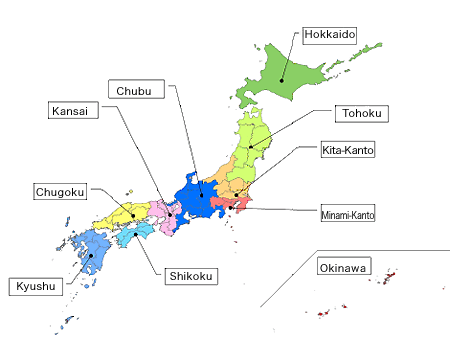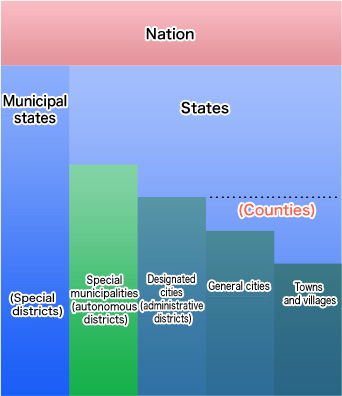The Future of Japan: A Case for Abolishing Prefectures and Establishing States
Nobuo Sasaki
Professor Emeritus, Chuo University
Area of Specialization: public administration, local governmental autonomy
Lessons Learned 150 Years After the Meiji Restoration
The duty of the government is to design a framework of the nation that is appropriate for the age. Times have changed dramatically 150 years after the Meiji Restoration (1868). As Japan faces the problem of an all-out population decline, I believe it's time to seriously debate how to approach a new way of building our nation. However, in the past couple of decades, the only political conversations we've been hearing are about economic measures. None of the discourse we hear focuses on the fundamental building blocks, such as administrative reform, or any attempt to review the structure in which our nation governs. This is political negligence.
This year will see nationwide local elections and the House of Councillors election take place. Members of both the ruling and opposition parties are totally consumed by these races, and are trying to outdo each other in a contest of sweeping promises. I worry about what kind of future these deceptive populist messages promising big rewards at small costs will lead us to. I fear it will mostly end up being a heavy burden on the citizens of Japan.
There is no future for a nation that has lost its ability to govern. Even if we approve of a hike in consumption tax as a temporary measure, if we maintain our current three-layered system of government that includes the national, prefectural and municipal governments, and the massive branch offices each of them have, no amount of tax increases will get us out of a budget deficit exceeding 1.2 quadrillion yen.
After the collapse of the bubble economy, the total annual national-local expenditures in Japan have exceeded 160 trillion yen, but the annual revenue from tax yields and other sources is less than 100 trillion yen. Since then, we've been pursuing a fiscal approach that tries to fill this gaping discrepancy with loans (such as deficit-covering bonds and municipal bonds). Let's take a closer look at this. Rather than allocating the 160 trillion yen in annual expenditures to provide services directly to the public, more than half of it is going to indirect expenditures such as public debt expenditures, labor costs and administrative expenses, all of which are being spent solely to maintain our governing structure. Any corporation with indirect expenditures that take up half of all spending cannot possibly survive.
This is the reason why citizens do not feel the prosperity, no matter how many times taxes are raised. Telling young people to dream big while ignoring this problem is a waste of energy. What awaits them in the future is a debt trap. This is the most irresponsible way of governing. In our history, the only period analogous to this situation would be the end of the Edo period (1603–1868). There are many lessons that can be learned from the events leading up to the Meiji Restoration, and the way the feudal system under the Tokugawa Shogunate failed, as it was meant to happen.
Institutional Fatigue and the Obsolescence of the Administrative Divisions
Japan's current governmental structure is designed for an age of population increase. Following the Meiji Restoration, Japan was experiencing an age of perpetual growth in terms of population, income and tax revenue. It was a growing society that was continually expanding. However, what lies ahead is a shrinking society. It will continue to go downhill, with the hill becoming steeper with each passing year. To cope with an age of population decline, we must adopt a simpler and more efficient system of government. One factor that needs to be extensively reviewed is the system of 47 administrative regions that has remained unchanged since its establishment in 1890.
As we move into the future, we expect to see more and more prefectures throughout Japan with populations dropping below a million people as the birthrate continues to decline. Currently, nine prefectures have populations of fewer than one million, including Kagawa and Wakayama, but in about 20 years, 10 more prefectures, including Nara, Nagasaki and Iwate will drop to similar levels, for a total of 19 prefectures. Moreover, there is an increasing number of prefectures with populations dropping by as much as 40%, with some prefectures dropping to levels that would not even meet the requirement for a government-designated city, which states that the population must at least be 700,000. While nearly half of all prefectures will become the size of medium-sized cities, there will be nearly 20 government-designated cities with over a million people. This increasingly prevalent phenomenon of reversal between broader-based local governments and municipalities will shake the current system of local governance at its core.
To use an analogy, we are keeping the same container as we had when our population was increasing, even when we have fewer things to put in it. This is absurd no matter how you look at it. The division into 47 prefectures that was established 135 years ago in the age of horses, ships and foot-travel is no longer compatible with today’s broader-based society. However, the current administrative regions that are trapped in this systemic structure are behaving as if they are 47 separate countries. As a result of each prefecture building its own airports—even if one would suffice in a broader region—we now have 97 airports throughout Japan. Over 90% are operating in the red. Prefectural governments that contain designated cities within its prefectural borders compete with those cities, and though needs decrease significantly due to a decline in population, they continue to create the same infrastructure and provide the same services. This system of government is creating a wasteful pattern of double and triple administrative redundancy.
Prefectural governments, which operated as a sort of wholesale trader between the nation and municipalities, have lost that role after the decentralization reform in the year 2000, and are becoming increasingly obsolete as they also are no longer tasked with processing massive amounts of agency-entrusted tasks of each ministry. Meanwhile, the number of designated cities that have had prefectural duties transferred to them has now reached 20, and the number of core cities has reached 60, causing a reversal in position. What happens when this counterintuitive governmental structure and the trend toward obsolescence are allowed to continue? It's massive tax increases for citizens and the deterioration of administrative services.
The Trend toward a Power Decentralization System

Figure 1: Illustration of administrative reform demarcation
From both economic and practical perspectives, our everyday lives take place in a large field that ignores prefectural boundaries. Local autonomy must be consistent between actual cities and administrative cities. However, the current system of 47 administrative regions is showing massive discrepancies—societal borders are broadening, while prefectural governance is narrowing.
There is an urgent need to enact a system of administrative cities that match the actual cities that are expanding, and to rebuild broader-based local governments that take the rapidly declining population into consideration. We must dismantle and reassess our old system of 47 administrative regions, integrate them into 10 states with borders dividing broader regions, and build a broader-based administrative system that is consistent with the actual everyday lives of citizens. This is what is referred to as the administrative reform proposal (Figure 1). This reform will save close to 20 trillion yen just from a fiscal perspective. We can cut about 10% of the consumption tax increase.
In the past couple of decades, Japan has decided that administrative power should be decentralized, and has pursued various systemic reforms. The amendments made in 2000 to 475 laws in one major reform known as the Omnibus Decentralization Law was the embodiment of this intent. The ultimate form of this decentralized nation was deemed to be the integration of prefectures into states, and a vision of reforms to meet that goal has been put forth. Over a decade ago, the first Abe administration (2006–2007) installed a cabinet minister for administrative reform, and the Administrative Reform Vision Council that was entrusted with its planning stated that Japan must make a complete transition by 2018 (March 2008 interim report), and is seeking to pass the necessary legislation.
This process was halted once when the Democratic Party of Japan (DPJ) took control, but when the Liberal Democratic Party (LDP) took back political power in December 2012, they drafted the Administrative Reform Promotion Law, and prepared to submit the bill with Komeito. However, after municipalities all over Japan staged an opposition movement just before the House of Representative election, claiming that the law would lead to widening disparities. The Abe administration, seeing that this would reflect badly just before an election, postponed the submission of the bill to the ordinary session of the Diet in the spring of 2014. Since then, the initiative has been consigned to obscurity.
However, regardless of the intentions of our politicians, the situation in the real world is becoming increasingly dire. The population decline is accelerating, the cumulative debt has exceeded 1.2 quadrillion yen, and about half of all municipalities are in danger of disappearing.
Creating the Japanese States Vision Based on Major Cities
The current system of fragmented regions united under a centralized system with the central power being located far from ordinary citizens is incompatible with the age we live in, no matter how we look at it. The solution to this is the transition to administrative reform. The entire nation of Japan is divided into about 10 large states, and significant decentralization is achieved with each state government becoming the center of internal administration. Taxes are collected and spent locally. As a result, waste is eliminated, populations and corporations disperse throughout the regions, and Japan as a whole regains its health.

Figure 2: A new system of the nation and its regions
This administrative reform has been mocked in the past as a fantasy. However, the basic fabric needed for this reform is already in place. The 20 designated cities should be elevated to special municipalities, the 60 core cities should be elevated to designated cities, and many of the prefectural duties should be transferred to these autonomous municipalities. On top of that, tasks handled by the ministry that are related to internal administration (MHLW, MLIT, MEXT, etc.), block agency tasks and tasks handled by existing prefectures should be integrated and handled by the newly-created state governments, making them the centers of internal administration. This is how this reform can be achieved (Figure 2). This reform proposal has been called doshusei in order to include Hokkaido (with do referring to Hokkaido), but if we uniformly use the suffix shu (state), for example, changing Hokkaido to "Hokkaido-shu," and Kyushu to "Kyushu-shu," we will no longer have to call it doshusei. I call this reform the Japanese States Vision.
From a historical perspective, the system of government that started in the Meiji period with four layers that comprised the nation, prefectures, districts (including some cities) and towns or villages later became three layers in the mid-20th century, comprising the nation, 47 administrative regions and municipalities. This reform of the future of the 21st century would change this to a system comprising the nation, states (including some municipal states) and cities (including some towns and villages). Many may worry about losing prefectural names that we've all grown accustomed to in our daily lives, but those will remain as place names, and the National High School Baseball Championship at Koshien which is based on the 47 prefectures will also remain. This will cause no difficulties in our everyday lives. There is a proposal to immediately abolish all prefectural functions as autonomous bodies, but they can remain as counties that supplement municipalities, other than the new special municipalities and the new designated cities, and just as the districts that were under the jurisdiction of prefectures naturally disappeared after a half-century, the counties that will serve as prefectures will follow a similar path.
There are three main objectives in transitioning to administrative reform.
First, Japan must change to a national polity with sovereign regions where decentralization has been implemented.
Second, the overconcentration of Tokyo must be mitigated, and competitive conditions that will allow each region to have independent vitality must be put in place.
Third, the government structure of national and regional governments must be simplified and transition into smarter, more efficient governing systems.
By transitioning to this administrative reform, each state can fully utilize the resources, legislative power, executive power and partial judicial power transferred from the national government, and start the process of becoming regionally independent. With each state becoming the center of internal administration, they will become the main administrators of a broad range of policies, including the maintenance of a range of infrastructure such as roads, airports and harbors, the promotion of science and technology, higher education including state-run universities, promotion of regional businesses and industries, trade with cities outside Japan, cultural exchanges, employment policies, public order within states, crisis management, environmental conservation and social security services such as medical-care insurance. Each state can also enact policies to reduce taxes to attract corporations. National political power will be dispersed, and state governor seats will be held by competent politicians. Eventually, a time will come when Japanese prime ministers will be chosen out of a field of state governors.
Seeing Administrative Reform as Analogous to the National Railway Reform
I often hear from people that they don't fully understand administrative reform. It currently has no substance, so that is understandable. However, it can roughly be compared to the national railway reform that took place 40 years ago. This is when Japan National Railways, which always operated in the red while trying to uniformly manage the railways of the entire country with one central source of funding and by a headquarter in Tokyo with its sloppy accounting, was privatized and divided into seven private companies (JR), leading to the revitalization of Japanese railways. At the time, the move was criticized and many predicted that it would lead to the abandonment of rural areas and regional disparities in the availability of services, but after 40 years, the results are clear. Each of the JR companies that are in charge of large regions have exerted various managerial efforts, leading to the spectacular revitalization of the national railways that were previously chronically in the red and had lost all sense of governance.
The administrative reform that would apply to the national and regional governments can be seen in the same light. To summarize the way things stand today, the national and regional governments are engaged in mutual back-scratching while operating under a 60 trillion-yen deficit, and unable to even reduce the annual expenditures as the cumulative debt reaches 1.2 quadrillion yen, with no clear bearer of administrative responsibility. Politicians try to outdo each other in publicity stunts while pushing forward with populist politics, with neither the ruling nor the opposition parties capable of even presenting a reform proposal. What future is there for this kind of mutual back-scratching politics and a national administration operating with sloppy accounting? The only future that could follow is the collapse of the nation.
Government failures and the annual revenue shortage are constantly being hidden behind loans, and once elections are over they'll move on to bickering and fault-finding while passing the debt burden on to citizens through tax increases. The similarities with the former Japan National Railways are undeniable.
When Japanese citizens are told to have hope in the future while this sort of governmental structure is allowed to continue, the words fall upon deaf ears. If the abolishment of feudal domains and the establishment of prefectures in the Meiji period was the political reform needed in an era of population growth, then the political reform required in this age of unprecedented population decline is the abolishment of prefectures and the establishment of states. The creation of truly functional regional governments—the revival of Japan must begin with this kind of major government structural reform. This major reform is a challenge that the Japanese government should face head-on.
- Nobuo Sasaki
Professor Emeritus, Chuo University
Area of Specialization: public administration, local governmental autonomy -
Nobuo Sasaki was born in 1948. He graduated from the Graduate School of Political Science at Waseda University, and earned a Ph.D. in law at Keio University. He worked at the Tokyo Government Office for 16 years, and in 1989, he became a professor at Seigakuin University, and then taught at Chuo University as a professor from 1994 to 2018. During this time, he worked as a visiting researcher at UCLA from 2000 to 2001, and then taught as a lecturer at Keio University, Meiji University, Nihon University, Saitama University and others. He is an expert in public administration and local governmental autonomy. He was a member of the 31st Local Government System Research Council, a member of the Science Council of Japan (the 22nd and 23rd terms) and a special advisor to Osaka prefecture and city. He became a professor emeritus of Chuo University in April 2018, board chairman of the Nihon Kunizukuri Kenkyujo (the Japan Nation Building Research Institute), and a visiting professor at Taiju Soken.

Main publications include Oiru Tokyo (Aging Tokyo) (Kadogawa Shinsho, March 2017), Chiho Giin no Gyakushu (The Revenge of the Local Representatives) (Kodansha Gendai Shinsho, March 2016), Jinkogensho Jidai no Chiho Soseiron (Creation of Regional Governments in the Age of Population Decline) (PHP Institute, March 2015), Aratana "Nihon no Katachi" (A New "Shape of Japan") (Kadogawa Shinsho, March 2013), Nihon Gyoseigaku (Japan's Public Administration) (Gakuyo Shobo, March 2013), and Tochiji—Kenryoku to Tosei (Tokyo Governor: Political Power and the Tokyo Metropolitan Government) (Chuko Shinsho, January 2011), among many others. He is a recipient of the NHK Regional Broadcasting Cultural Award and the Japan Society for Urban Studies Award. His new book Kono Kuni no Tatamikata—Haiken Chishu no Susume (How to Lay the Groundwork in Japan: Proceeding with the Abolishment of Prefectures and the Establishment of States) (Shincho Shinsho) is planned for release.
- Research Activities as a Member of Research Fellowship for Young Scientists (DC1), Japan Society for the Promotion of Science (JSPS) Shuma Tsurumi
- Important Factors for Innovation in Payment Services Nobuhiko Sugiura
- Beyond the Concepts of Fellow Citizens and Foreigners— To Achieve SDGs Goal 10 “Reduce Inequality Within and Among Countries” Rika Lee
- Diary of Struggles in Cambodia Fumie Fukuoka
- How Can We Measure Learning Ability?
—Analysis of a Competency Self-Assessment Questionnaire— Yu Saito / Yoko Neha - The Making of the Movie Kirakira Megane

-
Newest Edition 2019 Autumn Issue
Student journalists report on the students’ take of Chuo University

-
Chuo-DNA
The school's history and motto have been passed on to graduates and students alike. Here is a visualization of Chuo University in the future.Core Energy
Launching Chuo University's Knowledge into Action to the rest of the world, like an infinity of sparkling stars scattered throughout space.
Planned by The Yomiuri Shimbun Business Bureau [PR]















